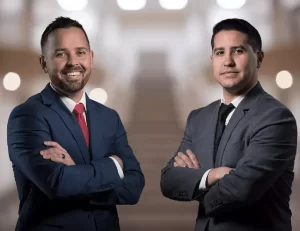
You are greeted with a warm friendly smile:) and a bottle of water. Wendy and Dave are amazing how they worked my case with all the challenges encountered . I’m thankful how all my medical appointments and treatments were arranged with top notch healthcare. Great communicator keeping you updated on the case. I appreciate how they endured, persevered after 11 months in resolving my settlement case. Many thanks
: )
You are greeted with a warm friendly smile:) and a bottle of water. Wendy and Dave are amazing how they worked my case with all the challenges encountered . I’m thankful how all my medical appointments and treatments were arranged with top notch healthcare. Great communicator keeping you updated on the case. I appreciate how they endured, persevered after 11 months in resolving my settlement case. Many thanks
: )
If you or a loved one were seriously injured in a motorcycle collision, please, contact our law firm to find out how we can help.
Meet the Attorneys

For nearly a decade, Mike and Tim collectively dedicated their efforts to defending the largest insurance companies and corporations worldwide while serving at Nevada’s top defense trial law firm. Witnessing firsthand the injustices inherent in the system, Mike and Tim united their strengths to safeguard the rights of the injured. Their mission is to prevent motorcycle accident victims from being overpowered, outmaneuvered, or manipulated by insurance entities or corporations.
Why Choose Valiente Mott?
- With an outstanding track record featuring over 500 five-star client reviews and an impressive 99% success rate, Valiente Mott is synonymous with excellence in legal representation. Our team consists of exceptional attorneys who are devoted to ensuring that each client receives the highest level of advocacy and support.
- Ensuring our clients’ needs remain paramount, we offer round-the-clock access to dedicated lines, ensuring assistance is available every day of the week. Through this unwavering commitment to accessibility, we aim to provide our clients with peace of mind and dependable guidance whenever they require it most.
- A significant portion of our clientele comes through referrals, underscoring the trust and confidence other legal professionals have in our expertise and unwavering commitment to excellence.
Recoverable Damages In A Las Vegas Motorcycle Accident Claim
In a Las Vegas motorcycle accident claim, recoverable damages are the various types of compensation that an injured motorcyclist can legally pursue. These damages are intended to compensate the victim for losses suffered due to the accident. Determining and calculating these damages requires a thorough understanding of both the immediate and long-term effects of the accident. The main categories of recoverable damages include:
- Medical Expenses: This covers all medical costs related to the accident, including hospital bills, medication costs, rehabilitation expenses, and future medical care if ongoing treatment is needed.
- Lost Wages and Loss of Earning Capacity: Compensation for lost wages includes income lost due to time away from work while recovering. If the injury impacts the victim’s ability to work in the future, they can also claim for loss of earning capacity.
- Pain and Suffering: This non-economic damage compensates for the physical pain and emotional distress suffered due to the accident. This includes compensation for ongoing discomfort, mental anguish, and reduced quality of life.
- Property Damage: This includes compensation for the repair or replacement of the motorcycle and any other personal property damaged in the accident.
- Permanent Disability or Disfigurement: If the accident results in permanent disability or disfigurement, the victim can seek compensation for the long-term impact on their life.
- Punitive Damages: In cases where the defendant’s actions were particularly reckless or egregious, punitive damages may be awarded as a way to punish the wrongdoer and deter similar conduct in the future.
- Wrongful Death: In the tragic event that a motorcycle accident leads to death, the victim’s family can pursue wrongful death damages, which may include funeral and burial expenses, loss of companionship, and loss of the deceased’s expected income.
Consult with our Las Vegas personal injury attorneys to explore the potential legal recourse and help you address the unique complexities of each vehicle type to secure the best possible outcome.
“I had a wonderful experience with Tim Mott and his staff. Tim was extremely professional, efficient, and trustworthy. He and his staff (Dave) were always available to address any questions or concerns. I knew he had my back and handled the entire process of my case quickly, and seamlessly with integrity.“
KRIS WELTE | GOOGLE REVIEW
“I have nothing but positive things to say about Valiente Mott. One thing that really stood out to me was their compassion and empathy. They understood how difficult it was for me and my family to go through the aftermath of our injuries. They were always there to provide support and encouragement.”
GRIMI PUERTO | GOOGLE REVIEW
How Do Bike Crashes Happen?
Like car and truck accidents, motorcycle collisions have many different possible causes. Our team of Las Vegas car accident attorneys share their expertise with a thorough investigation, effective negotiation with with insurance companies, and comprehensive legal representation. The most significant difference is the biker is not protected like the occupants in a car or truck. Here are some common causes of bike accidents:
- Lack of visibility Motorcycles are smaller and less visible compared to other vehicles, making them more susceptible to accidents, especially if other drivers are not diligently checking their blind spots. This lack of visibility often leads to collisions when other drivers fail to notice motorcycles nearby.
- Following too closely Motorcyclists are at higher risk when vehicles follow them too closely, as they require less distance to stop and the rear-ending impact can be more severe due to the motorcycle’s exposed nature.
- Driving too fast for the current road and weather conditions Motorcycles are more vulnerable to slipping or losing control in adverse weather conditions, making high speeds particularly dangerous. Drivers who fail to adjust their speed for the road and weather conditions can cause serious accidents involving motorcycles.
- Failure to yield on left turns This is a common cause of motorcycle accidents, as drivers making left turns may fail to see an oncoming motorcycle or misjudge its speed, leading to a collision.
- Unsafe lane changes Motorcycles can easily be hidden in a vehicle’s blind spot, and unsafe or abrupt lane changes without proper signaling and checking can lead to a sideswipe accident with a motorcyclist.
- Unsafe merges Merging into traffic without noticing a motorcycle can result in a collision, as motorcycles may be overlooked due to their size, particularly in heavy traffic conditions.
- Distracted driving When drivers are distracted, they are less likely to notice motorcycles around them, increasing the risk of accidents, especially in urban and high-traffic areas where motorcycles are more prevalent.
- Driving under the influence of alcohol or drugs Impaired driving reduces a driver’s reaction time and awareness, making it more difficult to notice and safely respond to motorcycles on the road.
- Falling asleep at the wheel This is extremely dangerous for motorcyclists, as dozing drivers can swerve unpredictably or drift into other lanes, posing a significant threat to nearby motorcyclists.
- Running a stop sign or red light This reckless behavior can be particularly hazardous for motorcyclists, as they might not have the structural protection to withstand such impacts, making collisions at intersections especially deadly.
Common Injuries In Motorcycle Accidents?
While all motor vehicle accidents can cause severe injuries, motorcycle crashes, in particular, can be even more dangerous because of the lack of protection.
Some of the injuries commonly associated with bike accidents include the following:
- Road rash: This injury is caused by sliding across the pavement during a bike accident, resulting in skin abrasions that can range from mild to severe, potentially leading to infections or permanent scarring.
- Bone fractures and breaks: Bike accidents commonly result in fractures or breaks, especially in the arms, legs, or ribs, due to the impact with vehicles, the road, or other objects.
- Severe cuts and lacerations: Sharp debris, broken glass, or the rough surface of the road can cause deep cuts and lacerations in a bike accident, which may require stitches and could lead to significant blood loss or infection.
- Neck, back, and spinal cord injuries: These injuries, ranging from whiplash to severe spinal cord damage, can occur in bike accidents due to the force of impact, potentially leading to long-term disability or paralysis.
- Brain injuries such as Traumatic Brain Injury (TBI): Even with a helmet, cyclists can suffer from TBIs or other brain injuries in accidents, which can have lasting effects on cognitive functions and mental health.
- Internal bleeding: Blunt trauma in bike accidents can cause internal bleeding, which is not immediately apparent but can be life-threatening if not promptly treated.
- Severe scarring or disfigurement: Injuries from bike accidents can leave permanent scars or lead to disfigurement, especially in cases of severe road rash or deep lacerations.
- Amputations: In extreme cases, a bike accident can lead to the loss of a limb or necessitate surgical amputation due to severe injury to the limb.
- Paralysis: Spinal cord injuries in bike accidents can result in partial or complete paralysis, dramatically altering a person’s life and requiring extensive rehabilitation and long-term care.
- Death: In severe cases, the trauma from a bike accident can be fatal, especially in collisions with larger vehicles or at high speeds.
Negligence In Las Vegas Motorcycle Accidents
Negligence in legal terms refers to the failure to take reasonable care to avoid causing injury or loss to another person. In the context of motorcycle accidents, establishing negligence is crucial as it determines who is legally responsible for the harm caused. In a Las Vegas motorcycle accident claim, the elements of negligence are as follows:
- Duty of Care: Every road user, such as a car driver, has the responsibility to act safely and adhere to traffic laws, which includes checking mirrors and blind spots before changing lanes, especially important when motorcycles are present.
- Breach of Duty: This occurs when the duty of care is not upheld, like when a car driver changes lanes without properly checking and collides with a motorcyclist legally occupying the adjacent lane.
- Causation: It’s crucial to establish a direct link between the breach of duty and the accident, as in the case where the accident directly results from the car driver’s failure to check for the motorcyclist.
- Damages: The accident must result in actual harm or loss, such as the motorcyclist suffering a broken leg and motorcycle damage, leading to medical expenses and loss of income during recovery.
Lane Splitting In Las Vegas
Lane splitting is prohibited under NRS 486.351. Lane splitting is defined as motorcyclists navigating between lanes of slow-moving or stationary traffic. The rationale behind this law is centered on safety. Lane splitting can lead to accidents due to the unpredictable movements of motorcycles squeezing between vehicles, often in tight spaces. These maneuvers can catch other motorists off guard, especially if they are not expecting a motorcycle to pass through narrowly separated lanes. By outlawing lane splitting, Nevada aims to minimize the risk of collisions caused by such sudden and close interactions between motorcycles and other vehicles. This law is particularly pertinent in urban areas like Las Vegas, where traffic congestion can tempt motorcyclists to engage in lane splitting.
Helmet Requirement For Las Vegas Motorcyclists
Nevada’s Helmet Law (NRS 486.231) is a vital safety regulation for motorcycle riders and their passengers throughout the state. This law mandates that all individuals on a motorcycle, whether drivers or passengers, must wear helmets that meet the safety standards established by the Department of Transportation. The primary intent of this law is to reduce the severity of head injuries, which are common and often severe in motorcycle accidents. Helmets are a critical line of defense, significantly lowering the risk of traumatic brain injuries and fatalities in crashes.
Steps To Take After A Motorcycle Accident
If you are injured in a motorcycle crash caused by another person – such as the driver of a passenger vehicle, you may have grounds to file a motorcycle accident lawsuit and receive financial compensation for your injuries. As soon as the crash occurs, however, there are some crucial steps that bike accident victims can take to help maximize the amount of their financial recovery in Nevada motorcycle accident cases:
- Call the police and see that an accident report has been filed.
- Seek medical attention as soon as possible, even if you are not experiencing any symptoms
- If possible, take pictures of every vehicle involved in the crash, your injuries, damaged property, the accident scene, the road, weather, and traffic conditions at the time of the crash, and any posted traffic signs nearby.
- Collect the contact information of all eyewitnesses to the accident.
- Consult an experienced Las Vegas motorcycle accident attorney before providing a recorded statement to the insurance company or accepting any settlement offers.
- While your claim is being litigated, assume at all times that a private investigator is following you and live your life accordingly.
- Do not post anything about your accident on social media. Additionally, ensure that no one else posts any updates, videos, or pictures that could harm your case.
How We Approach Your Case At Valiente Mott
At Valiente Mott, we bring a unique combination of qualities to our handling of Las Vegas motorcycle accident claims, ensuring the best possible service for you:
- Experienced Legal Representation: Our team is composed of highly skilled attorneys with top-tier academic backgrounds, particularly adept in handling significant injury cases like motorcycle accidents. Our extensive knowledge is crucial for navigating the complexities of your case.
- Personalized Client Service: We pride ourselves on our client-centric approach. When you choose us, you receive personalized attention and support throughout your legal journey, ensuring your specific needs and circumstances are at the forefront of our strategy.
- Proven Success and No-Risk Policy: Our impressive success rate in accident claims, backed by numerous positive client testimonials, speaks volumes. Furthermore, we operate on a contingency fee basis, meaning you pay no attorney fees unless we win your case. This policy underscores our commitment to securing the best outcome for you.
- Comprehensive Case Management: At Valiente Mott, we offer full-service case management. From in-depth investigations to negotiating with insurance companies and, if necessary, representing you in court, we handle all aspects of your claim, allowing you to focus on your recovery.
Choosing Valiente Mott means partnering with a firm that not only offers exceptional legal experience but also a dedication to your individual needs and a commitment to achieving the best possible results for your motorcycle accident claim.
Contact Us At Valiente Mott For A Free Consultation
When clients hire us, they know our experienced Las Vegas motorcycle accident attorneys will immediately begin investigating and building their case and communicate with any potential expert witnesses and the insurance company. They will also ensure that all legal deadlines are met and attempt to negotiate a favorable settlement with the insurance company.
If you have been injured in a motorcycle accident in Las Vegas, NV, call Valiente Mott today to arrange a free, no-obligation case evaluation. And since we work on a contingency fee basis, you will not pay attorney’s fees unless we win compensation for your injuries. We look forward to hearing from you.











